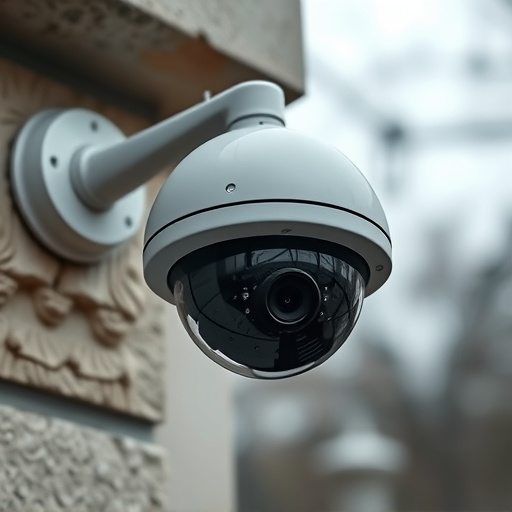Strategic placement of fake security cameras at 45-60 degree angles horizontally and eye level vertically can deter crime without the cost of a full surveillance system. These cameras, with durable housing, adjustable focal lengths, infrared LEDs, and motion detection, offer flexible monitoring options for residential and commercial properties, filling blind spots where real cameras might not be feasible. Realistic placement and features like wide-angle lenses and infrared capabilities enhance their deterrent effect.
“Uncover the power of dummy security dome cameras, a strategic addition to any surveillance system. This comprehensive guide explores the art of placement, delving into the optimal angles for fake security camera positioning. We dissect key components that make these devices effective, from advanced technology to realistic design. Discover the versatile benefits and diverse use cases, whether enhancing actual security or creating the illusion of vigilance. Learn how to choose the perfect dummy camera to meet your specific requirements.”
- Understanding Fake Security Camera Placement Angles
- Key Components of a Dummy Dome Camera
- Benefits and Use Cases for Fake Security Cameras
- Choosing the Right Dummy Camera for Your Needs
Understanding Fake Security Camera Placement Angles
Understanding the optimal placement angles for fake security camera is key to enhancing your home or business’s security perception. While real cameras often point directly at targets, dummy cameras serve best when positioned at slightly off-center angles. This mimics natural observation points and gives the appearance of a fully operational system, even if no recording is taking place.
Placement should consider both horizontal and vertical axes. For horizontal angle, aim for around 45 to 60 degrees away from the target area. Vertically, positioning the camera at eye level or slightly above creates a more convincing surveillance image. Avoid direct line-of-sight views, as this might alert potential intruders of enhanced security measures. By adhering to these fake security camera placement angles, you can create an effective deterrent without breaking the bank.
Key Components of a Dummy Dome Camera
The key components of a dummy security dome camera include its housing, lens, and image sensor. The housing is designed to mimic the appearance of a real security camera, often made from durable materials like metal or high-quality plastic, ensuring it can withstand various weather conditions. This outer casing also protects the internal mechanisms from physical damage and provides a secure base for Fake Security Camera Placement Angles, such as on walls, ceilings, or other strategic locations to deter potential thieves or vandals.
The lens is responsible for capturing video footage, with different focal lengths offering varying field of views. Wider angles are ideal for covering larger areas, while narrower lenses provide enhanced detail at closer ranges. Integrated infrared LEDs or passive infrared sensors enable the camera to capture images in low-light conditions, ensuring round-the-clock surveillance. Additionally, some models feature motion detection capabilities, triggering alerts when activity is detected within the camera’s range.
Benefits and Use Cases for Fake Security Cameras
Fake security cameras, also known as dummy or decoy cameras, offer a range of benefits for both residential and commercial properties. One of their primary advantages is deterrence. By strategically placing these cameras at various angles, homeowners and business owners can significantly reduce the risk of theft, vandalism, and other crimes. The visual presence of surveillance equipment acts as a powerful psychological deterrent, often discouraging potential perpetrators before they even attempt an illegal act.
These cameras are versatile in their application. They can be installed on walls, ceilings, or visible outdoor areas to monitor entry points, parking lots, and perimeter fences. Ideal for placing at blind spots or hard-to-reach angles where real security cameras might not be feasible or visible. This technology is particularly useful for businesses looking to enhance their security without the high cost of installing multiple real camera systems.
Choosing the Right Dummy Camera for Your Needs
When selecting a dummy security dome camera, understanding your specific needs is key. Different environments require varied features and specifications. For instance, if you’re focusing on deterrence in high-traffic areas like entranceways or parking lots, opt for cameras with wide-angle lenses offering clear, detailed footage from various placement angles—including vertical, horizontal, and even tilted positions to capture every nook and cranny.
Fake security camera placement is crucial for realism. Choose models that mimic genuine camera positioning, such as those mounted on ceilings or walls, ensuring they blend seamlessly into your surroundings. Additionally, consider cameras with infrared capabilities for nighttime visibility, adding another layer of protection and authenticity to your chosen Fake Security Camera Placement Angles.
In conclusion, understanding the strategic placement angles of fake security dome cameras is key to enhancing your property’s security without compromising aesthetics. By familiarizing yourself with the essential components and benefits outlined in this article, you can select the perfect dummy camera to meet your specific needs. Remember, the right choice can deter potential threats while maintaining a serene environment.
